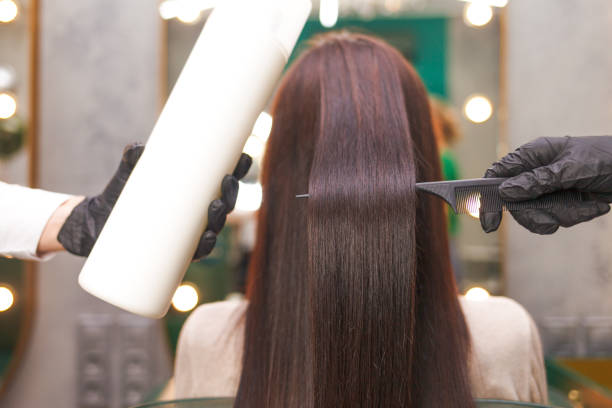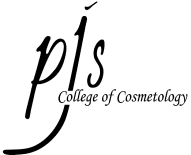September 2, 2025
Complete Guide to Chemical Hair Straightening: Techniques, Safety, and Professional Protocols

Professional Chemical Hair Straightening: Complete Guide for Beauty Professionals
Chemical hair straightening remains one of the most profitable and sought-after services in the beauty industry. However, it also presents significant risks and requires extensive knowledge of hair chemistry, proper technique application, and safety protocols. This comprehensive guide covers everything beauty professionals need to know about chemical straightening services, from basic chemistry to advanced troubleshooting.
Understanding Hair Structure and Chemical Straightening Science
Natural Hair Structure and Bonds
Hair’s natural curl pattern results from the arrangement of chemical bonds within the hair shaft:
- Disulfide Bonds: Strong chemical bonds that determine hair’s permanent structure and curl pattern
- Hydrogen Bonds: Weaker bonds affected by moisture and heat, responsible for temporary styling
- Salt Bonds: Ionic bonds affected by pH changes, contributing to hair’s overall structure
- Van der Waals Forces: Weak attractions between molecules that contribute to hair’s shape
The Straightening Process Explained
Chemical straightening works by breaking and reforming the hair’s disulfide bonds:
- Reduction Phase: Chemical relaxers break existing disulfide bonds, allowing hair to be reshaped
- Molding Phase: Hair is combed or brushed into straight position while bonds are broken
- Neutralization Phase: Chemical neutralizers reform bonds in the new straight configuration
- Stabilization: Hair structure stabilizes in its new straight form
Types of Chemical Straightening Systems
Sodium Hydroxide (Lye) Relaxers
Characteristics:
- Strength: Most effective at breaking disulfide bonds
- Processing Time: Fastest acting, typically 8-20 minutes
- pH Level: Extremely high (12-14), very alkaline
- Hair Compatibility: Best for coarse, resistant hair types
- Professional Considerations: Requires extensive experience and careful monitoring
Usage Guidelines:
- Strand Testing: Always perform 24-48 hours before full application
- Scalp Protection: Use protective base to prevent chemical burns
- Timing Precision: Cannot be left on longer than recommended times
- Neutralization: Requires thorough neutralizing to stop chemical action
Calcium Hydroxide (No-Lye) Relaxers
Benefits:
- Gentler Action: Less harsh on hair and scalp than sodium hydroxide
- Slower Processing: More forgiving timing, reduced risk of over-processing
- Home Use: Often found in consumer products
- Scalp Sensitivity: Better option for sensitive scalps
Professional Considerations:
- Drying Effects: Can leave hair drier than lye relaxers
- Buildup Issues: May cause calcium buildup requiring clarifying treatments
- Moisturizing Needs: Requires intensive conditioning treatments post-service
- Retouch Timing: May need more frequent applications
Ammonium Thioglycolate Systems
Characteristics:
- Dual Action: Can straighten or add curl depending on technique
- Processing Method: Hair wrapped or combed during processing
- pH Level: Lower than hydroxide systems (8.5-9.5)
- Versatility: Can achieve various degrees of curl reduction
Application Techniques:
- Wrapping Method: Hair wound around rods for curl reduction
- Comb-Through Method: Hair combed straight during processing
- Sectioning Patterns: Strategic sectioning ensures even application
- Timing Variations: Different areas may require different processing times
Keratin Straightening Treatments
Modern Innovations:
- Formaldehyde-Free Options: Safer alternatives to original formulations
- Temporary to Semi-Permanent: Results last 3-6 months
- Heat Activation: Requires flat iron sealing for full effectiveness
- Gradual Fading: Results diminish gradually rather than growing out
Professional Application:
- Preparation: Clarifying shampoo removes buildup before treatment
- Section Application: Methodical application ensures even coverage
- Heat Sealing: Flat iron work locks treatment into hair shaft
- Aftercare Instructions: Specific maintenance requirements for longevity
Client Consultation and Assessment
Comprehensive Hair Analysis
Visual and Tactile Examination:
- Curl Pattern Assessment: Determine natural texture and curl type (Type 1-4)
- Hair Density: Evaluate thickness and number of hairs per square inch
- Hair Porosity: Test absorption rate and processing requirements
- Elasticity Testing: Assess hair’s ability to stretch and return to normal
- Damage Evaluation: Look for signs of previous chemical or thermal damage
Chemical History Documentation:
- Previous Relaxer Treatments: Type, timing, and results of past services
- Color Services: Any bleaching, coloring, or highlighting history
- Thermal Damage: Regular heat styling, flat iron, or blow dryer use
- Medical Factors: Medications, hormonal changes, or health conditions affecting hair
Strand Testing Protocol
Pre-Service Testing Requirements:
- Test Section Selection: Choose inconspicuous area representative of overall hair condition
- Timing Documentation: Record exact processing time for successful results
- Result Assessment: Evaluate straightness, hair condition, and any adverse reactions
- Formula Adjustment: Modify chemical strength or timing based on test results
- Client Approval: Ensure client understands and approves expected results
Application Techniques and Safety Protocols
Pre-Service Preparation
Scalp and Hair Preparation:
- Scalp Assessment: Check for cuts, abrasions, or irritation that contraindicate service
- Protective Measures: Apply protective base around hairline and ears
- Hair Sectioning: Create systematic sections for even application
- Tool Preparation: Ensure all tools are clean and ready for use
Professional Application Process
Systematic Application Method:
- Back Sections First: Start at nape where hair is typically most resistant
- Avoid Overlapping: Apply only to new growth, never over previously relaxed hair
- Even Distribution: Use smooth, consistent strokes for uniform coverage
- Constant Monitoring: Check processing every few minutes for optimal results
- Immediate Response: Stop processing at first sign of desired straightness
Safety Monitoring During Service:
- Client Comfort: Regular check-ins about burning or discomfort
- Processing Assessment: Visual monitoring of straightening progress
- Timer Management: Strict adherence to maximum processing times
- Emergency Procedures: Immediate neutralization if problems arise
Neutralization and Post-Service Care
Proper Neutralization Techniques
Critical Neutralization Steps:
- Thorough Rinsing: Remove all chemical relaxer with lukewarm water
- Neutralizing Shampoo Application: Apply neutralizer systematically to all processed areas
- Processing Time: Allow neutralizer full recommended contact time
- pH Testing: Ensure hair returns to normal pH levels (4.5-5.5)
- Final Rinse: Remove all neutralizing product completely
Post-Relaxer Conditioning
Immediate Conditioning Protocol:
- Protein Treatments: Strengthen hair structure damaged during chemical process
- Moisture Replacement: Deep conditioning to restore hydration
- pH Balancing: Ensure hair cuticle properly closes after service
- Heat Protection: Prepare hair for styling without additional damage
Troubleshooting Common Problems
Over-Processing Issues
Signs of Over-Processing:
- Excessive Hair Stretching: Hair stretches significantly without returning to normal length
- Breakage During Service: Hair breaks during combing or rinsing
- Mushy Texture: Hair feels gummy or loses its natural elasticity
- Scalp Irritation: Burning, itching, or visible redness on scalp
Corrective Measures:
- Immediate Neutralization: Stop processing immediately and begin neutralization
- Intensive Conditioning: Apply deep conditioning treatments to restore hair health
- Protective Styling: Recommend gentle handling and protective styles during recovery
- Follow-Up Appointments: Schedule regular conditioning treatments
Under-Processing Solutions
Identifying Under-Processing:
- Insufficient Straightening: Hair retains too much natural curl or wave
- Uneven Results: Some sections straighter than others
- Rapid Reversion: Hair returns to natural texture quickly after styling
Corrective Options:
- Retouch Application: Apply relaxer only to insufficiently processed areas
- Timing Adjustment: Slightly longer processing time in future services
- Formula Strength: Consider stronger relaxer formulation for resistant hair
- Technique Modification: Adjust application method for better penetration
Maintenance and Aftercare Education
Client Education Essentials
Immediate Post-Service Care:
- 48-Hour Rule: No washing, sweating, or moisture exposure for 48 hours post-relaxer
- Gentle Handling: Avoid tight hairstyles, harsh brushing, or manipulation
- Sleep Protection: Use satin pillowcases or bonnets to prevent friction
- Weather Precautions: Avoid humidity and rain that can cause reversion
Long-Term Maintenance Guidelines:
- Moisturizing Routine: Daily moisturizing with appropriate products
- Protein Balance: Regular protein treatments to maintain hair strength
- Heat Protection: Always use heat protectant before styling tools
- Professional Maintenance: Schedule regular trims and conditioning treatments
Retouch Scheduling and Timing
Optimal Retouch Intervals:
- Standard Timing: Every 6-8 weeks for most clients
- Growth Rate Factors: Adjust based on individual hair growth patterns
- Hair Health Considerations: Extend intervals if hair shows stress or damage
- Seasonal Adjustments: Consider climate and lifestyle factors affecting timing
Advanced Techniques and Specializations
Corrective Straightening Services
Fixing Previous Chemical Damage:
- Assessment Protocols: Evaluate extent of damage and realistic expectations
- Gradual Improvement: Multiple sessions for severely damaged hair
- Specialized Products: Use gentler formulations designed for damaged hair
- Intensive Conditioning: Incorporate regular reconstructive treatments
Texture Services for Natural Hair
Working with Virgin Hair:
- Education Requirements: Understanding of natural hair care principles
- Texture Considerations: Adapting techniques for different curl patterns
- Cultural Sensitivity: Respecting clients’ natural hair journey and preferences
- Gradual Approaches: Offering texturizing rather than complete straightening
Business Aspects of Chemical Straightening
Pricing Strategies
Service Pricing Factors:
- Time Investment: Chemical services require 2-4 hours of professional time
- Product Costs: High-quality relaxers and treatments represent significant expense
- Skill Level: Advanced techniques command premium pricing
- Risk Factors: Higher liability requires appropriate compensation
- Market Position: Premium services at professional pricing levels
Legal and Insurance Considerations
Professional Protection:
- Liability Insurance: Specific coverage for chemical services
- Consent Forms: Detailed waivers explaining risks and aftercare requirements
- Documentation: Thorough records of consultations, tests, and services performed
- Continuing Education: Regular training to maintain competency and reduce risk
Health and Safety Regulations
Chemical Safety Protocols
Ventilation Requirements:
- Adequate Airflow: Proper ventilation to minimize chemical exposure
- Personal Protection: Gloves, aprons, and eye protection for professionals
- Client Protection: Ensure client comfort and safety during processing
- Emergency Equipment: Eyewash stations and first aid supplies readily available
Regulatory Compliance
State Board Requirements:
- License Requirements: Specific training and certification for chemical services
- Sanitation Standards: Proper cleaning and disinfection of all tools and surfaces
- Record Keeping: Maintaining client service records as required by law
- Continuing Education: Staying current with safety updates and new techniques
Future Trends in Chemical Straightening
Innovation in Product Development
Emerging Technologies:
- Gentler Formulations: New chemistry reducing damage while maintaining effectiveness
- Customizable Systems: Products tailored to individual hair types and conditions
- Sustainable Options: Eco-friendly alternatives to traditional chemicals
- Smart Monitoring: Technology assisting in timing and process monitoring
Market Evolution
Industry Trends:
- Natural Hair Movement: Increased appreciation for natural textures
- Temporary Solutions: Growing preference for non-permanent straightening options
- Health Consciousness: Greater awareness of chemical exposure and safety
- Personalized Services: Customized treatments based on individual hair analysis
Education and Professional Development
Specialized Training Requirements
Advanced Education Opportunities:
- Manufacturer Training: Specific product line certification programs
- Advanced Techniques: Workshops on corrective and specialized services
- Safety Updates: Regular training on new safety protocols and regulations
- Cultural Competency: Education on working with diverse hair textures
Career Advancement Through Specialization
Professional Growth Paths:
- Chemical Services Specialist: Focus on relaxers, perms, and corrective services
- Texture Expert: Specialization in natural hair and cultural styling
- Educator Role: Training other professionals in chemical services
- Salon Management: Overseeing chemical service departments
At PJ’s College of Cosmetology, our comprehensive cosmetology program includes extensive training in chemical services, emphasizing both technique and safety. Students gain hands-on experience with various chemical straightening systems under close instructor supervision, ensuring they graduate with the knowledge and confidence to perform these advanced services safely.
Our curriculum covers the science behind chemical processing, proper consultation techniques, application methods, and troubleshooting skills that prepare graduates for immediate success in chemical services. We emphasize the business aspects of these profitable services while maintaining the highest safety standards.
